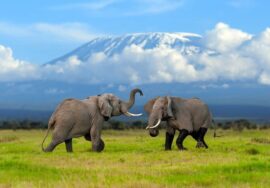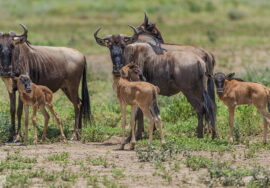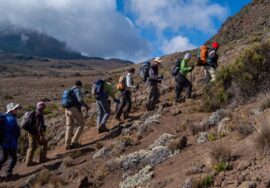
Guide to trees in Tanzania
Guide to trees in Tanzania. It’s possible that you will see a lot of different types of habitat on your safari.
A yellow fever tree might be near wet places like the edges of rivers, swamps, and floodplains.
A huge number of yellow fever trees grow near water. The trees are very tall and striking. Their wide branches and yellow bark make them easy to spot.
The “yellow” part of their name comes from their bark.
People used to think that the trees, not being close to water, caused malaria, which is where the “fever” part of the name comes from.
You will almost certainly see these lovely trees on your tour.
Baobab Tree
Tanzania not only has a lot of beautiful wildlife, but it also has a lot of beautiful nature. Here is a list of the most popular and well-known trees in Tanzania that you will see on your safari.
Tanzania is a great place to visit if you love animals and the outdoors.
A tour is a great way to see a lot of nature as well as animals. You may not have thought about this before.
Every country in Africa, including Tanzania, is like this.
Trees that you might see on your tour in Tanzania
We’ll look at some of the most popular trees in Tanzania that you might see on a safari in this article.
So, read on if you want to know more!
Tree of Yellow Fever
It’s possible that you will see a lot of different types of habitat on your safari.
A yellow fever tree might be near wet places like the edges of rivers, swamps, and floodplains.
A huge number of yellow fever trees grow near water. The trees are very tall and striking. Their wide branches and yellow bark make them easy to spot.
The “yellow” part of their name comes from their bark.
People used to think that the trees, not being close to water, caused malaria, which is where the “fever” part of the name comes from.
You will almost certainly see these lovely trees on your tour.
Baobab Tree
During your tour in Tanzania, you might also see a baobab tree. Around the world, there are more than nine kinds of baobab trees. The largest species is found in Tanzania.
People call baobabs “upside down trees” because the branches that are twisted up look a lot like roots. When you go on safari, you will most likely see these trees in parts of the forest that are hot and dry.
Baobabs are beautiful trees that can be found all over Tanzania. There is a good chance that you will probably see one during your tour.
Candelabra of Happiness
The euphoria candelabra is another very popular tree in Tanzania that you will see on your safari.
There are a lot of these trees in Tanzania. They are a type of succulent plant.
Because they are plants, they have such unique looks.
The branches of the Euphoria Candelabra start about 3 meters up the tree and keep going up, which is different from many other trees where the branches end near the top.
There have been times when these trees have been over 20 meters tall, but most of the time they are only about 12 meters tall.
You should stay away from these trees even though they are very pretty because they give off latex that is deadly.
This rubber can irritate the skin if it comes into contact with it. That’s why it’s best to look at these trees from afar.
Date Palm in the Wild
When we talk about Tanzanian trees that look different, the wild date palm (Phoenix Reclinata) is the next one.
The fact that this tree grows in a lot of different places is very strange.
This tree doesn’t seem to do well in just one set of settings. Instead, you can find it doing well in many places across Tanzania.
These trees usually grow in groups of three to six meters high.
You might think these trees are bushes from a distance because they grow so close to each other that the branches of the different trees tend to touch.
The wild date palm is a tree that bears fruit. You can eat the fruit, but it doesn’t taste very good.
In many parts of Tanzania, the tree’s sap is used to make palm wine instead. It’s possible that you will see this tree while you are on safari.
The most common tree in Tanzania is the acacia.
The acacia is one of the most popular trees in Tanzania that you will likely see on your safari.
People all over Africa know that giraffes eat acacia trees, which grow in many different places all over the continent.
In Tanzania, there are a lot of acacia trees, and giraffes like to eat the leaves and roots.
The acacia is the first tree that comes to mind when you think of trees in Tanzania.
A lot of TV shows and movies have shown acacia trees, which are often thought of as being from Africa.
It would be hard to find a place in the grassland where an acacia tree is not growing.
In Tanzania, acacia trees not only give giraffes and other animals food, but they also keep the land stable.
That’s why there are so many of them in Tanzania: they are an important part of the environment.
Tree with Sausage
We agree that this sounds like a strange tree, but we are almost certain that you will see a sausage tree on your trip.
The flowers on this tree look a bit like sausages, but the tree itself doesn’t make them. That’s how the tree got its name.
This tree looks really beautiful from far away. There is no doubt that it is beautiful; it usually grows to be about 20 meters tall.
They are beautiful because they are both tall and wide. These trees are usually found in the wet parts of sub-Saharan Africa.
The fruit that grows on this Tanzanian tree makes it look nice, but it doesn’t smell good.
Strangely enough, this strong and unpleasant smell is good for something: it draws dwarf epauletted fruit bats.
The fruit bats fertilize the trees’ fruit, which helps the trees grow well.
It is dangerous to eat the fruit itself, but it has been used successfully to make a number of skin goods.
The Strangler Fig
Some of the plants in Tanzania are the same trees that make up the canopy of the Saharan forest.
One of these trees that you see a lot is the strangler fig.
They get their name from the fierce way they feed themselves. They can grow to be anywhere from 6 to 21 meters tall.
It is a hemiepiphyte, like the strangler fig. This means the tree needs a home in order to grow.
This plant’s seed falls from the tree’s top to the ground. It then grows on a host plant until the host plant dies.
The strangler fig takes over that spot from the host tree when this happens.
The way the strangler fig grows really shows that the circle of life affects more than just animals. It also affects plants.
Most of the time, you can find this tree in Tanzania near the Serengeti rivers.
Toothbrush Tree
A big tree is probably what you picture when you think of a tree. A tree that is taller than all the other plants and animals in its area.
The toothbrush tree, on the other hand, is not like this. In relation to a person, the toothbrush tree will be tall, but it’s only about 4 to 6 meters tall.
That’s why it’s not as long as most of the other trees in this book. This tree is easy to spot because of how tall it is.
It’s not called a “toothbrush tree” just because it looks like a toothbrush.
It got this name because it was used to make traditional toothbrushes, which were then called “tooth sticks” in many places.
But its use in oral hygiene has been called into question since then.
The toothbrush tree is a type of evergreen plant. Its leaves are green and its trunk is brown.
This tree’s leaves are often used to make medicine in Tanzania. They are also sometimes eaten as a salad.
Most of the time, the toothbrush tree will stand out against the sand while you’re on safari.
Tanzanian trees: a brief outline
We’ve only looked at a few of the usual trees you might see on a safari in Tanzania in this guide.
Tanzania is home to many beautiful animals and other wonderful wildlife. During your trip, make sure you look out for these Tanzania flowers.








